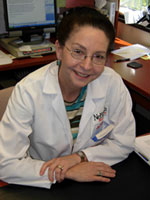 |
Jane Potter, M.D. |
Dr. Potter, immediate past president of the American Geriatrics Society and chief of geriatrics and gerontology at UNMC, hopes the federal and state governments and Americans in general heed a new federal report released April 14 by the U.S. Institutes of Medicine (IOM).
Geriatricians are specialists who provide health care for those over the age of 65. Currently there are only 7,000 geriatricians in the United States — about half of what is needed to deal with America’s geriatric population.
The report, “Retooling for an Aging America: Building the Health Care Workforce,” calls for bold initiatives starting immediately to train all health care providers in the basics of geriatric care and to prepare family members and other informal caregivers in how to tend to their aging loved ones.
A key recommendation in the report was that Medicare, Medicaid and other health plans should pay higher rates in order to boost recruitment and retention of geriatric specialists and care aides.
“The Institute of Medicine Report is really a wakeup call for America,” Dr. Potter said. “It speaks to a need to educate health care professionals differently, to structure our health systems differently, to pay attention to families, to pay attention to the needs of family caregivers and to look at how we can assist family caregivers to provide better care for their aging relatives.
“It says pay more attention to how we train home care providers and providers across the settings of care where older people reside.”
The report indicates that as the first of the nation’s 78 million baby boomers reach age 65 in 2011, they will face a health care work force that is too small and woefully unprepared to meet their specific health needs.
The IOM report sets a target date of 2030 — the year by which all baby boomers will have turned at least 65 — for the necessary reforms to take place.
The IOM is a component of the National Academy of Sciences, which enlists distinguished members of professions to examine public health policy matters. It advises the federal government on issues of medical care, research and education.
Far too few physicians are entering geriatrics to keep pace with the need, Dr. Potter said.
|
|
“The conclusions in the report are what we’ve been talking about as geriatric medicine specialists for the last 25 years,” Dr. Potter said. “Every health care professional needs an increased mount of education. Geriatrics need to be integrated in the curriculum of every health professional school.
“We need a cadre of specialist teachers, not just in geriatric medicine but in nursing, social work, pharmacy and the therapies,” Dr. Potter said. “All of the agencies that license and credential health care training programs must increase training requirements in the care of older patients. And as health care educators — we need a keen awareness to make sure that our curriculum provides the necessary training to meet the needs of the aging.”
If needs aren’t met, there will be increased problems with delivering adequate care to older patients, she said.
“Care for complex, chronic illness is very different than for medical care in midlife,” Dr. Potter said. “We need providers who focus on care that allows for people to remain functional and autonomous and have a good quality of life and to age successfully into their later years.”
The country faces an impending crisis as the growing number of older patients, who are living longer with more complex health needs increasingly outpaces the number of health care providers with the knowledge and skills to care for them capably, said the report’s committee chair, John Rowe, M.D., professor of health policy and management at the Mailman School of Public Health at Columbia University in New York.
“The sheer number of older patients in the coming years will require trying new models for delivering health care and the commitment of greater financial resources,” he said.
Other key findings from the report included:
Work Force Shortage Threatens Quality of Care — Though there’s an overall shortage of health care workers in all fields, the situation is worse in geriatric care because it attracts fewer specialists than other disciplines and experiences high turnover rates among direct-care workers — nurse aides, home health aides and personal care aides.
Higher Salaries, Financial Incentives Needed — The report says Medicare, Medicaid and other health plans need to pay more for the services of geriatric specialists and direct-care workers to attract more health professionals to geriatric careers and to stanch turnover among care aides, many of whom earn wages below the poverty level. Salaries of doctors, nurses, pharmacists, social workers and others who specialize in geriatric care lag behind those of their counterparts in other fields.
Medicare Hinders Delivery of Quality Care — The IOM committee noted several ways that Medicare hinders the provision of quality care for older adults, including Medicare’s low reimbursement rates, its focus on treating short-term health problems rather than managing chronic conditions or age-related syndromes, and its lack of coverage for preventive services or for health care providers’ time spent collaborating with a patient’s other providers.
“The Medicare program is a great program and works great if you’re only trying to treat acute illnesses, but most of the illnesses in people over the age of 65 are chronic illnesses,” Dr. Potter said. “The model needs to be modified to help people that have multiple and chronic illnesses who require ongoing care and monitoring. These people require help from health professionals between the face-to-face encounters.”
The report was sponsored by the John A. Hartford Foundation, Atlantic Philanthropies, Josiah Macy Jr. Foundation, Robert Wood Johnson Foundation, Retirement Research Foundation, California Endowment, Archstone Foundation, AARP, Fan Fox and Leslie R. Samuels Foundation, and Commonwealth Fund.
For more information on the report, or to purchase the full report, click here.
Material from the National Academies was used in this story.